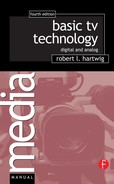Encoding more information produces better pictures.
Digital Encoding Ratios
From Black and White to Color
When color television was finally adopted in the United States in 1953, black and white TV had already been around for several years. To ensure that the black and white TVs and the new color TVs could show all of the same programs, engineers decided to start with the black and white signal and add the color information to it. The black and white or luminance signal is designated as “Y” Since each of the three primary colors contains luminance information, it would be redundant and use too much bandwidth to have a separate luminance signal and three separate color or chrominance signals. The solution is to take the Y channel for luminance, which is mostly green information (since green makes 59% of white light), and two color signals: red with the luminance information removed (R-Y) and blue with the luminance information removed (B-Y). This allows recreation of the full color picture without using more bandwidth than is necessary.
Digital Responses to This Situation
When developing a digital system, engineers have to make choices about how accurately they want to reproduce the picture and how much bandwidth they want to use. One choice they make is with digital encoding ratios. A digital encoding ratio is the relationship of how much luminance and how much chrominance information are encoded digitally. The international broadcast standard is 4:2:2. What that means is that if we were to take four pixels from the TV screen, all four of them would have the Y or luminance information encoded, and two of the pixels would have the R-Y information and the B-Y information encoded. If we had 4:1:1 encoding, which some companies use in consumer color cameras, then all four pixels would have the luminance information encoded, and one would have both the R-Y and B-Y information encoded.
Obviously, the more information that is encoded, the more accurate the picture. But you will use more bandwidth and will pay more money for the better quality. A problem is created, however, when you try to use several pieces of digital equipment together. If one has 4:2:2 encoding and you try to hook it up to something that has 4:1:1 encoding, it probably won't work. The equipment may have built-in converters, but when you constantly convert from one digital format to another, you begin to lose quality. It is critical that you and your engineering staff ensure that all digital equipment in a facility is compatible with each other.
1. 4:2:2 encoding.
2. 4:1:1 encoding.


